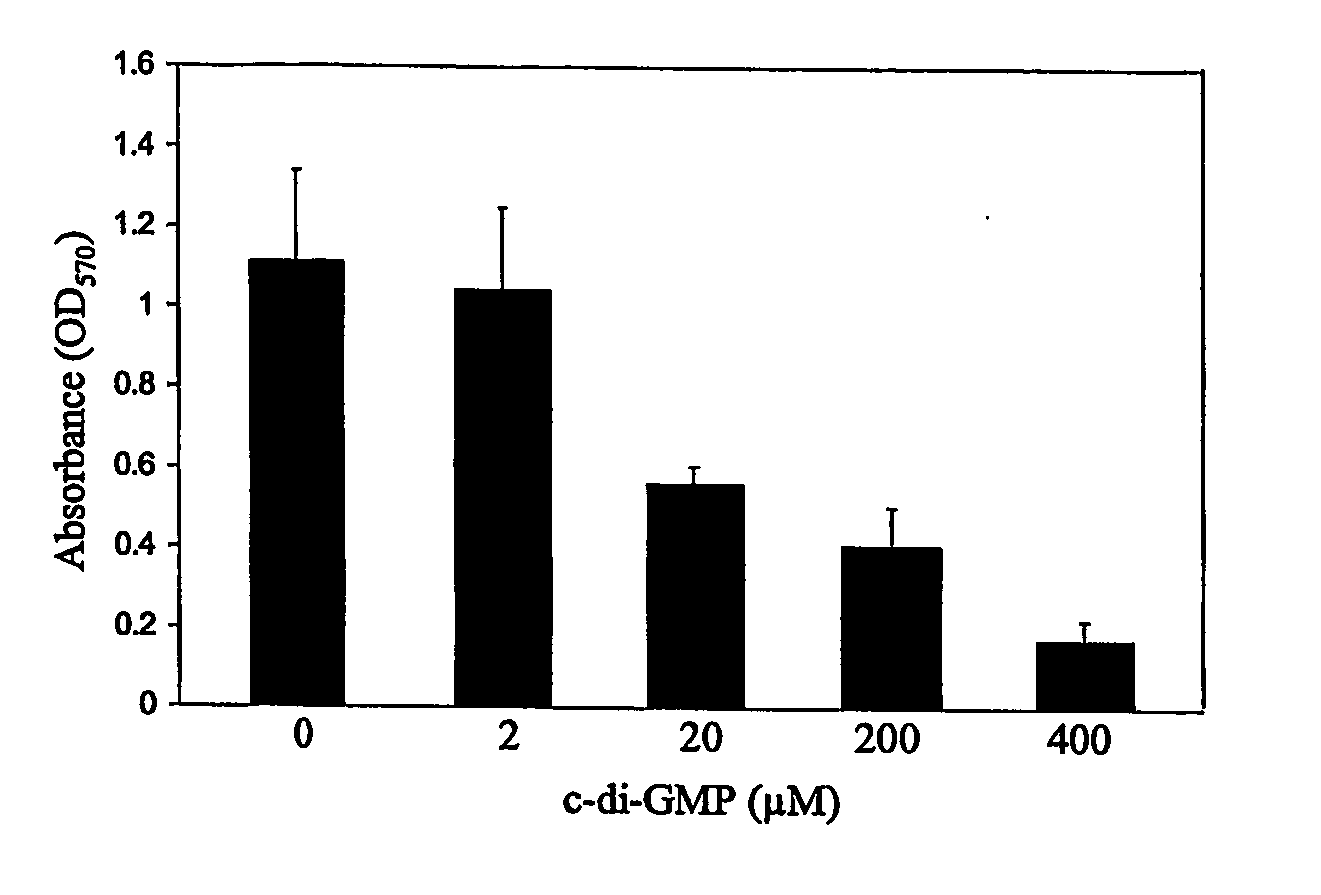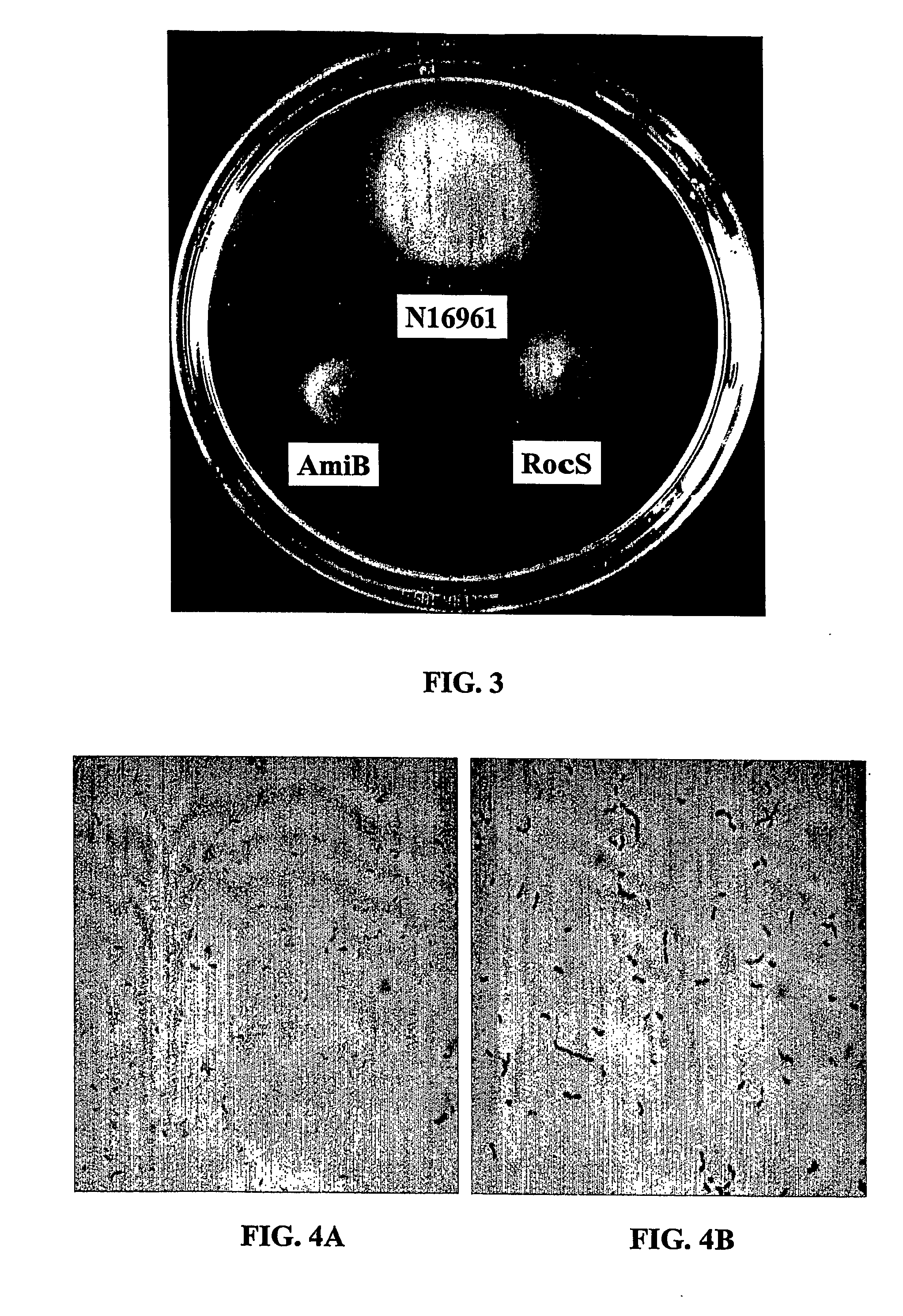Method For Attentuating Virulence Of Microbial Pathogens And For Inhibiting Microbial Biofilm Formation
a microbial pathogen and attentuating virulence technology, applied in the direction of biocide, antibacterial agents, drug compositions, etc., can solve the problems of untreated diarrhea, death, and unreported microbial pathogens, and achieve the effect of inhibiting or reducing colonization, attentuating the virulence of a microbial pathogen, and reducing the number of infections
- Summary
- Abstract
- Description
- Claims
- Application Information
AI Technical Summary
Benefits of technology
Problems solved by technology
Method used
Image
Examples
example 1
[0069] Researchers studying the rugose phenotype of V. cholerae (and other species) have been impeded by the very low (<1%) frequency of switching between smooth (EPSoff) and rugose cells (EPSon) in vitro (Morris et al., 1996; Wai et al., 1998; White, 1940 and 1938; Yildiz et al., 1999). The laboratory of the present inventor has identified culture media and conditions, APW#3 (1% proteose peptone #3, 1% NaCl, pH 8.5.), which results in a high frequency shift of smooth cells (EPSoff) to the rugose phenotype (EPSon). This process is called high frequency rugose production (HFRP) (Table 1) (Ali et al., 2002).
TABLE 1Frequency of switching to rugose EPS production(HFRP) by V. cholerae strains.% Rugose coloniesFlaskTubeSerogroup / 30°37°30°37°StrainsaBiotypeSourcebC.C.C.C.N16961O1 / El TorC (1971)24-3842-5168-7460-80C6709O1 / ElTorC (1991)1231570NCTC 6585O1 / C (1943)33-4844-4500classicalAMS20A73O1 / C (1945)3400classicalAldovaO37C (1965)0171-7223-501803non-O1C (1992)0016871837O139C (1992)00.200-...
example 2
[0078]Vibrio cholerae can switch to a “rugose” phenotype characterized by an exopolysaccharide (EPS) matrix, wrinkled colony morphology, increased biofilm formation and increased survival under specific conditions. The vps gene cluster responsible for the biosynthesis of the rugose EPS (rEPS) is positively regulated by VpsR. Media (APW#3) promoting EPS production and the rugose phenotype was identified and epidemic strains were found to switch at higher frequency than nonpathogenic strains, suggesting this switch and extracellular polysaccharide is important in cholera epidemiology. In the experiments in this example, transposon mutagenesis on a smooth V. cholerae strain was used to identify mutants that were unable to shift to the rugose phenotype under inducing conditions to better understand the molecular basis of the switch. The present inventor identified vpsR, galE and vps previously associated with the rugose phenotype, and also identified genes not previously associated incl...
example 3
[0097]Staphylococcus aureus is an important pathogen of humans and animals and its antibiotic resistance is a public health concern. Biofilm formation is essential in pathogenesis, and the ability to form biofilms and resist traditional antibiotic treatments often results in difficult-to-treat and persistent infections. As such, novel antimicrobial approaches are of great interest to the scientific, medical and agricultural community. The present inventor proposed in Example 1 that modulating levels of the cyclic dinucleotide signalling molecule, c-di-GMP (3′, 5′-cyclic diguanylic acid), has application in regulating phenotypes of prokaryotes. In the experiments described below in this example, extracellular c-di-GMP shows activity against human clinical and bovine intramammary mastitis isolates of S. aureus, including methicillin-resistant (MRSA) strains. The present example shows that chemically synthesized c-di-GMP is soluble and stable in water physiological saline and stable fo...
PUM
| Property | Measurement | Unit |
|---|---|---|
| Antimicrobial properties | aaaaa | aaaaa |
Abstract
Description
Claims
Application Information
 Login to View More
Login to View More - R&D
- Intellectual Property
- Life Sciences
- Materials
- Tech Scout
- Unparalleled Data Quality
- Higher Quality Content
- 60% Fewer Hallucinations
Browse by: Latest US Patents, China's latest patents, Technical Efficacy Thesaurus, Application Domain, Technology Topic, Popular Technical Reports.
© 2025 PatSnap. All rights reserved.Legal|Privacy policy|Modern Slavery Act Transparency Statement|Sitemap|About US| Contact US: help@patsnap.com



